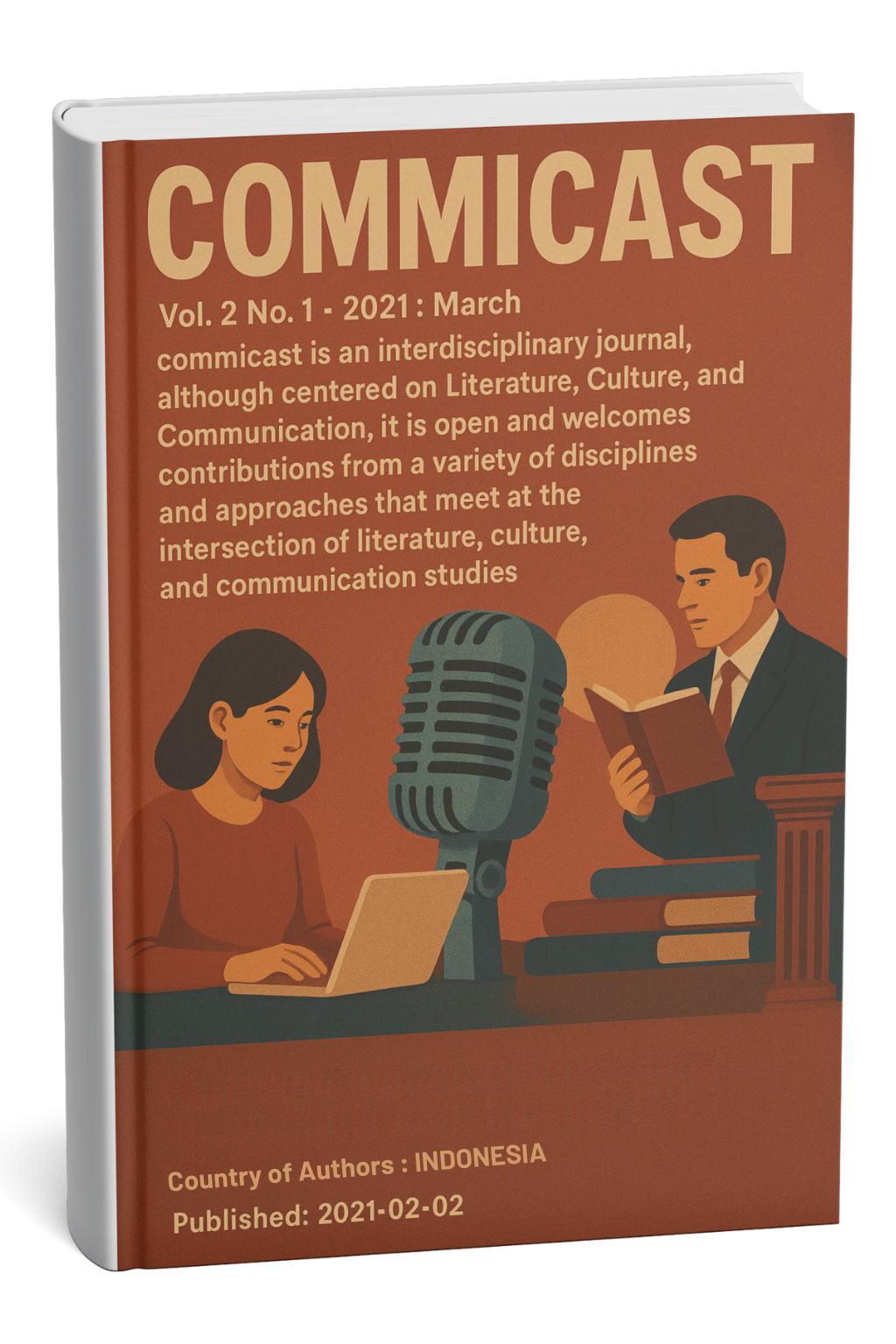Hierarchy of human needs in the main character of beauty is a wound by Eka Kurniawan
DOI:
https://doi.org/10.12928/commicast.v2i1.2734Abstract
On this research, the researcher has aim to find out the main character Dewi Ayu’s human needs and identify the most dominant needs. In this study, the researcher applied the psychological approach and theory of human needs. This research is a qualitative descriptive study. The writer uses a library research method to collect the data. It means that the writer visit the library and reads the novel then read several related books. The main data is novel beauty is a wound by Eka Kurniawan, while supporting data is obtained from books, articles, and the internet. The result of this study can be explained that the main character can not totally fulfill well, such as: (1) the physiological needs of the main character can be fulfilled well because she is from a wealthy family (2) the safety can not be fulfilled due to factors in that era (3) the love and belonging need can be fulfilled well because the main character has a beautiful appearance (4) the esteem needs can be fulfilled because she is a famous figure at that time (5) self-actualization needs also can be fulfilled well because the main character is a brave and is able to position herself very well. From the five hierarchy needs the most dominant need is safety needs.
Â
References
Binnemans, K., Jones, P. T., Müller, T., & Yurramendi, L. (2018). Rare Earths and the Balance Problem: How to Deal with Changing Markets? Journal of Sustainable Metallurgy. https://doi.org/10.1007/s40831-018-0162-8
Burton, S., & Burton, S. (2020). Day 1. In The ELSA Trainers’ Manual. https://doi.org/10.4324/9781003072447-7
Center for Food Safety and Applied Nutrition. (2012). Foodborne Illnesses: What You Need to Know.
de Clercq, R. (2013). Beauty. In The Routledge Companion to Aesthetics. https://doi.org/10.4324/9780203813034
Hijmans, R. J. (2020). raster: Geographic analysis and modeling with raster data. : R Package Version 3.1-5.
Ilyin, M., & Peirce, C. (2019). WHAT IS A SIGN? In METOD. https://doi.org/10.31249/metod/2019.09.25
Kuo, P. H., & Chung, Y. C. E. (2019). Moody microbiome: Challenges and chances. Journal of the Formosan Medical Association. https://doi.org/10.1016/j.jfma.2018.09.004
Kurland, A. A. (1975). Maslow. The Journal of Nervous and Mental Disease. https://doi.org/10.1097/00005053-197506000-00012
Kurniawan, E., Raveinal, R., Fauzar, F., & Arsyad, Z. (2016). Nilai Diagnostik Metode “Real Time†PCR GeneXpert pada TB Paru BTA Negatif. Jurnal Kesehatan Andalas. https://doi.org/10.25077/jka.v5i3.609
Kurniawati, A., Liana, L., Asharina, N. P., & Permana, I. (2018). Kajian Feminisme dalam Novel Cantik Itu Luka Karya Eka Kurniawan. Parole (Jurnal Pendidikan Bahasa Dan Sastra Indonesia).
Quinet, K. (2011). Prostitutes as victims of serial homicide: Trends and case characteristics, 1970-2009. Homicide Studies. https://doi.org/10.1177/1088767910397276
Stoyanov, S. (2017). A theory of human motivation. In A Theory of Human Motivation. https://doi.org/10.4324/9781912282517
Downloads
Published
How to Cite
Issue
Section
License
License and Copyright Agreement
In submitting the manuscript to the journal, the authors certify that:
- They are authorized by their co-authors to enter into these arrangements.
- The work described has not been formally published before, except in the form of an abstract or as part of a published lecture, review, thesis, or overlay journal. Please also carefully read Commicast's Posting Your Article Policy at http://journal2.uad.ac.id/index.php/commicast/about/editorialPolicies#custom-5
- That it is not under consideration for publication elsewhere,
- That its publication has been approved by all the author(s) and by the responsible authorities – tacitly or explicitly – of the institutes where the work has been carried out.
- They secure the right to reproduce any material that has already been published or copyrighted elsewhere.
- They agree to the following license and copyright agreement.
Copyright
Authors who publish with Commicast agree to the following terms:
- Authors retain copyright and grant the journal right of first publication with the work simultaneously licensed under a Creative Commons Attribution License (CC BY-SA 4.0) that allows others to share the work with an acknowledgment of the work's authorship and initial publication in this journal.Â
- Authors are able to enter into separate, additional contractual arrangements for the non-exclusive distribution of the journal's published version of the work (e.g., post it to an institutional repository or publish it in a book), with an acknowledgment of its initial publication in this journal.
- Authors are permitted and encouraged to post their work online (e.g., in institutional repositories or on their website) prior to and during the submission process, as it can lead to productive exchanges, as well as earlier and greater citation of published work.
Licensing for Data Publication
Commicast use a variety of waivers and licenses, that are specifically designed for and appropriate for the treatment of data:
Open Data Commons Attribution License, http://www.opendatacommons.org/licenses/by/1.0/ (default)
Creative Commons CC-Zero Waiver, http://creativecommons.org/publicdomain/zero/1.0/
Open Data Commons Public Domain Dedication and Licence, http://www.opendatacommons.org/licenses/pddl/1-0/
Other data publishing licenses may be allowed as exceptions (subject to approval by the editor on a case-by-case basis) and should be justified with a written statement from the author, which will be published with the article.
Open Data and Software Publishing and Sharing
The journal strives to maximize the replicability of the research published in it. Authors are thus required to share all data, code or protocols underlying the research reported in their articles. Exceptions are permitted but have to be justified in a written public statement accompanying the article.
Datasets and software should be deposited and permanently archived inappropriate, trusted, general, or domain-specific repositories (please consult http://service.re3data.org and/or software repositories such as GitHub, GitLab, Bioinformatics.org, or equivalent). The associated persistent identifiers (e.g. DOI, or others) of the dataset(s) must be included in the data or software resources section of the article. Reference(s) to datasets and software should also be included in the reference list of the article with DOIs (where available). Where no domain-specific data repository exists, authors should deposit their datasets in a general repository such as ZENODO, Dryad, Dataverse, or others.
Small data may also be published as data files or packages supplementary to a research article, however, the authors should prefer in all cases a deposition in data repositories.























